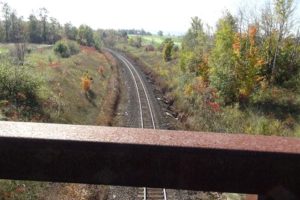
Sunday at Glen Abbey GC at last year’s RBC Canadian Open.
The Town of Oakville vs ClubLink legal battle is teetering on holy war status. There appears to be no compromise in the offing, with both sides entrenched in what they see as a very black and white issue.
On the one hand, ClubLink contends that the Town of Oakville is standing in the way of running its business the way it sees fit. On the other side, both the Town and Halton Region are adamant that they’re not going to have a private enterprise force them into changing the rules of the game.
“Any municipality that cannot defend its official plan’s rules for land use doesn’t really have an official plan and its neighbourhoods are wide open to whatever developers want,” Mayor Rob Burton told the Oakville Beaver newspaper. “That’s why council and I are so committed to defending our town and its policies.”
I was among a few members of the public in the Town of Oakville’s Bronte meeting room yesterday as the two sides presented their positions regarding the upcoming Local Planning Appeal Tribunal (LPAT) hearings on the matter. ClubLink wants one prolonged set of hearings for both sides to present their cases on why (and why not) the upper lands of Glen Abbey GC should be rezoned and their development proposal approved—a proposal, incidentally, that includes 3,222 residential units, including nine apartment buildings ranging from nine to 12 storeys each. The plan also includes another 176,000 sq. ft. of commercial, retail and office space.
The Town’s position, supported by Halton Region, Conservation Halton and the Fairway Hills Community Association (all of whom were present yesterday) is that the hearings should be broken into two separate phases. The first would address the more fundamental question of whether the current ClubLink proposal should be approved at all based upon heritage lands issues as well as Oakville’s urban structure.
“This represents, by far, the single largest proposal the Town has ever received for development in its built-up area,” observed Robert Howe, a partner in Goodmans LLP and legal representative for the Town of Oakville. “It proposes a fundamental change in land use and a new master-planned community. It isn’t just another golf course conversion that is opposed by the neighbourhood. Even ClubLink’s own consultant agrees that there is a cultural heritage landscape of significance within the property.
“In the Town’s view, there are two fundamental policy-based planning considerations that warrant refusal of the application—the first being in relation to cultural heritage conservation and second in relation to urban structure,” Howe said. “From the Town’s perspective, these are threshold issues, because they cannot be addressed by modifications to the applications, or through the submission of additional technical analysis by the applicants. These issues are so fundamental that they close the gate to further considerations for proposed redevelopment.”
Howe also cited “serious deficiencies in the studies and supporting materials submitted” by ClubLink, as well as design issues, including the positioning of roads and storm water management ponds, and whether the community could be properly serviced, but that all those technical details should be addressed in Phase Two, should the hearing be required to move beyond the first phase.
The Town and the Region’s hope is that LPAT will agree to the two-phase approach, and then subsequently rule in Oakville’s favour after Phase One, thereby saving all parties millions of dollars and several additional months in legal battles.
ClubLink argues, however, that this is a merely a delay tactic and that they’d be prejudiced by such a two-phase decision, and that such an approach could extend hearings another two years, although it’s unclear how they reached that estimation.
The ClubLink proposal would create a new strategic growth area 57 hectares in size, Howe noted, with some 6,581 residents and an additional 243 jobs. “The development would constitute 22% of (previously) forecasted residential growth within the built boundary that is anticipated over the 25-year planning period,” Howe said.
As a local resident, I wonder whether the proposed development could be adequately supported by Town infrastructure, particularly since the area is bordered by two major arteries—Dorval Drive and Smith-Triller Viaduct (the Upper Middle Road bridge)—both of which cannot be widened, and where traffic is already becoming a concern for residents.
This new “node” of development, the Town argues, is not in line with the provincial plan of optimizing density along transit corridors. The tribunal’s chair yesterday, Gerald Swinkin, countered that Glen Abbey GC is already within the built-up boundary and that the Livable Oakville plan anticipates intensification within its built-up area. Howe, though, responded that ClubLink’s proposal far exceeds what the Town would ever have anticipated for that tract of land and that this is an “inappropriate location” to create a new node.
“So are you saying that the intensification here exceeds a critical mass that would otherwise fall within the general (rules) of intensification?” Swinkin asked.
“Yes, exactly,” Howe responded.
Howe believes all discussions should be concluded in Phase One.
The fact that Saw-Whet GC off Bronte Rd., not far west of Glen Abbey GC, is in the process of being developed, should not be construed as a similar case study, Howe contends, as that evolution was always anticipated by the Town’s planning department.
“The nature and the scale of the (ClubLink) development” at Glen Abbey, on the other hand, is something completely different, suggests Howe, who allowed that “the tribunal has to make a decision on the proposal before it, and it can modify (the proposal). But the tribunal is not entitled to approve something that is fundamentally different than what is proposed.”
The compact meeting room also included the two legal representatives for ClubLink (lead council Mark Flowers among the duo), as well as representatives from Halton Region, Conservation Halton and the Fairway Hills Community Association (the members of which border the existing golf course.) The Fairway Hills rep, Denise Baker of WeirFoulds LLP, argued the merits of splitting things into separate phases to allow residents a better opportunity to attend the proceedings, and felt that those residents has been disrespected by ClubLink instead of being embraced in the procedure—a contentious issue given that they are the ones most affected by the proposal.
“To suggest, as Mr. Flowers has done, that my clients ought to have known that this would be a 20-week hearing is a statement, I submit, without merit,” Baker said. “In fact, knowing that the lands are designated under Ontario Heritage Act, I fully expect that the question of whether the proposed development can succeed on these lands would have to be determined in advance of (hearing) evidence as to whether such a development can be serviced appropriately.”
Precedents of phasing similar decisions were cited by Baker as well as the Town of Oakville and their supporting parties.
The lone supporter for ClubLink that I noticed in the meeting room was Oakville resident Jill Gowland, who studiously kept notes throughout the proceeding. It was Gowland’s passionate Freedom of Information Actrequests that helped reveal that theTown of Oakville has now spent almost $9 million in its legal fight to preserve Glen Abbey GC.
The Town of Oakville, however, has a reservoir of approximately $40 million to deal with such litigation (as well as unforeseen storm events). Most of that, admittedly, is likely to get consumed if this fight goes the distance.
And what if ClubLink loses? They can simply resubmit a revised proposal, a Halton Region rep advised. And on and on we go.
But what if the issue wasn’t black and white? What if it were grey? In a perfect world, I can’t help but wonder whether the ideal scenario would be for ClubLink to accept defeat, withdraw its current proposal and resubmit a compromise that proposes, say, 50% of the current plan.
The reality is that the RBC Canadian Open is done like dinner, as far as Glen Abbey is concerned, and Golf Canada has no intention of bringing it back. So the tournament revenue the Town used to count on—almost annually—has dried up and gone.
Further, ClubLink never had a long-term plan for Glen Abbey GC anyway. Make no mistake—this was always a real estate play for Rai Sahi, when, as CEO of Morguard Corp., he acquired Glen Abbey in two separate chunks in 2001 and 2007.
As Sahi told the Globe and Mail in 2017, “The only thing I knew was that I was in the real estate business, and these guys have got 10,000 acres of land, which may be worth something.”
At its heart, ClubLink Corp. is a landowner more than it is a golf course operator.
Some golf analysts have alluded to the Glen Abbey situation as a thinning of the herd—part of an economic correction for a market that was over-built in the 1990s. But that’s not precisely what’s happening here. The market is not ‘correcting’ so much as it is selectivelythinning—with developers scooping up prime GTA real estate at a time when land is very hard to find for homebuilders. Consider York Downs selling its property for $412 million. Who can say no to such generous offers?
If Glen Abbey does disappear, Oakville will be left with the grand total of three golf courses—Oakville Executive GC, Deerfield GC and the private Oakville GC. That’s two public courses for a population of 200,000.
In my perfect world, a compromise could be struck between the two parties that might leave a nine-hole public layout on the Glen Abbey grounds. Lord knows Oakville could use it.
It might also help address some of the heritage concerns the Town has, including the appropriate commemorative plaques positioned throughout the layout.
Taxes from the new community, filled with high-end residences, would help refill the Town’s rainy-day reservoir. Parkland and ponds bordering the Fairway Hills development could help appease those residents.
Sahi and company might make a couple hundred million dollars less from developers, but it will still have proved a savvy and massively lucrative business transaction.
And the Town of Oakville and Halton region could have the satisfaction of having stood tall on their philosophical ground, while making the best of a challenging situation and planning for the inevitable future.
All we need to do is brush away that line in the sand, lest both parties become bunkered for a debilitatingly prolonged period.



2 Comments
Leave your reply.